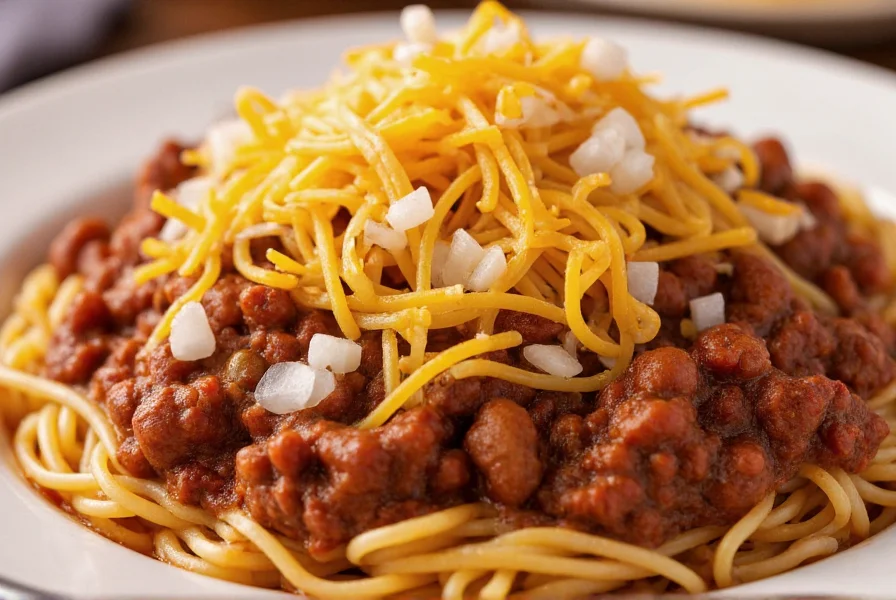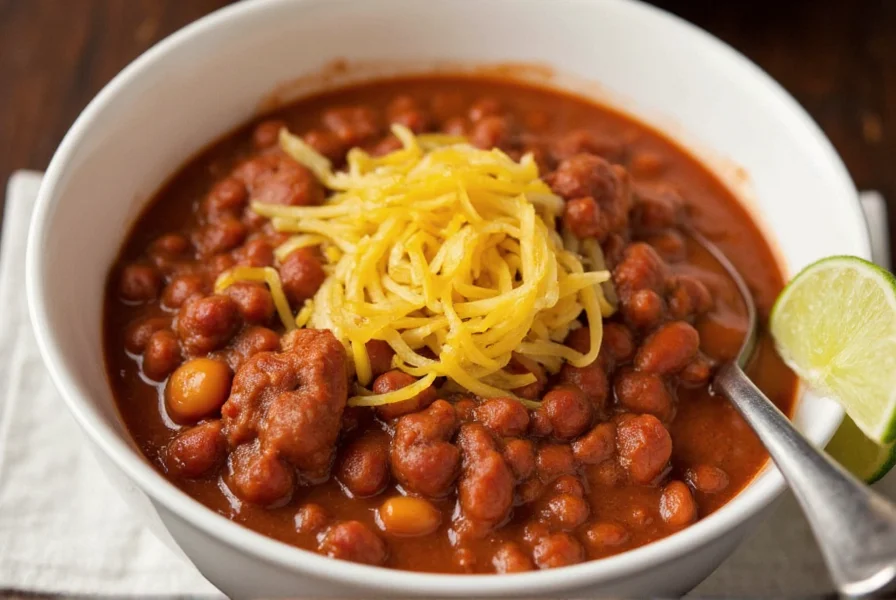The Definitive Guide to Making Authentic Cincinnati Chili
When you search for recipe for cincinnati chili, you're looking for more than just another meat sauce—you're seeking a taste of Ohio's unique culinary tradition. Unlike Texas-style or chili con carne, Cincinnati chili has distinctive Mediterranean-inspired spices and specific serving styles that make it a regional treasure.
What Makes Cincinnati Chili Different?
Understanding the authentic cincinnati chili recipe ingredients begins with recognizing what sets this dish apart. Cincinnati chili features:
- A thin, broth-like consistency rather than thick stew
- Warm spices including cinnamon, allspice, and sometimes cocoa
- Served over spaghetti (never beans in the base recipe)
- Specific "way" serving styles (3-way, 4-way, 5-way)
- No chili powder as the primary seasoning
Created by Macedonian and Greek immigrants in the 1920s, this regional specialty has become synonymous with Cincinnati dining culture, with chains like Skyline Chili and Gold Star defining the style for generations.
Traditional Cincinnati Chili Recipe
This classic cincinnati chili recipe serves 6-8 and takes approximately 2 hours from start to serving (mostly simmering time).
| Category | Ingredients |
|---|---|
| Meat Base | 1.5 lbs ground beef (80/20) |
| Spice Blend | 2 tsp cinnamon, 1.5 tsp allspice, 1 tsp cloves, 1 tsp cumin, 0.5 tsp chili powder, 1 tbsp cocoa powder |
| Liquid Components | 4 cups beef broth, 1 (14.5 oz) can tomato sauce, 2 tbsp Worcestershire sauce, 2 tbsp apple cider vinegar |
| Thickener | 2 tbsp cornstarch + 2 tbsp cold water |
Step-by-Step Cooking Instructions
Follow these steps for the best homemade cincinnati chili that captures the authentic taste:
- Brown the beef: In a large pot, cook ground beef over medium heat until no longer pink. Drain excess fat but retain some for flavor.
- Add aromatics: Stir in 1 diced onion and 2 minced garlic cloves. Cook until softened (about 5 minutes).
- Build the base: Add tomato sauce, beef broth, Worcestershire sauce, and vinegar. Bring to a gentle simmer.
- Season properly: This is crucial for authentic cincinnati style chili recipe—add all spices including the distinctive cinnamon and allspice blend. Many beginners skip these key elements.
- Simmer patiently: Cover and simmer on low heat for 1.5-2 hours, stirring occasionally. The longer it simmers, the better the flavor develops.
- Thicken appropriately: Mix cornstarch with cold water and stir into chili. Simmer 5 more minutes until slightly thickened (Cincinnati chili should remain relatively thin).
- Rest before serving: Let chili sit off heat for 15-20 minutes to allow flavors to meld.

Serving Cincinnati Chili the Traditional Way
The unique serving style defines Cincinnati chili. Unlike other chili varieties, it's always served over spaghetti with specific topping combinations called "ways":
- 2-way: Chili over spaghetti
- 3-way: Chili, spaghetti, and shredded cheddar cheese
- 4-way: 3-way plus either onions or beans
- 5-way: 3-way plus both onions and kidney beans
For the most authentic cincinnati chili experience, serve with oyster crackers on the side and a glass of ice-cold cola—a traditional pairing in Cincinnati diners.
Common Mistakes to Avoid
Many homemade cincinnati chili recipes miss the mark because of these common errors:
- Using too much chili powder: Traditional Cincinnati chili uses minimal chili powder—focus on the warm spices instead
- Making it too thick: It should have a broth-like consistency, not a stew texture
- Skipping the simmer time: Authentic flavor develops through slow simmering
- Adding beans to the base recipe: Beans are a topping option (5-way), not part of the chili itself
- Using pre-shredded cheese: Freshly shredded cheddar melts better for that authentic 3-way experience
Variations and Substitutions
While purists might balk, these cincinnati chili recipe variations can accommodate different dietary needs without losing the essential character:
- Vegetarian option: Substitute beef with textured vegetable protein and use vegetable broth
- Gluten-free: Serve over gluten-free spaghetti or rice
- Milder version: Reduce cloves and chili powder while maintaining cinnamon and allspice
- Spicier version: Add a pinch of cayenne or red pepper flakes

Storage and Reheating Tips
One advantage of this traditional cincinnati chili recipe is that it tastes even better the next day. Store properly for maximum flavor:
- Refrigerate in airtight container for up to 5 days
- Freeze for up to 3 months (thaw in refrigerator before reheating)
- Reheat gently on stove with a splash of broth or water to restore proper consistency
- Never microwave directly from frozen—thaw first for best texture
Why This Recipe Works
This authentic cincinnati chili recipe step by step captures the essence of the regional specialty by respecting the traditional spice profile and preparation methods. The balance of sweet and savory spices creates that distinctive flavor Cincinnati residents know and love. Unlike many online recipes that Americanize the dish with excessive chili powder, this version honors the Mediterranean influences that make Cincinnati chili unique among American chili varieties.
Frequently Asked Questions
What's the difference between Cincinnati chili and regular chili?
Cincinnati chili has a thinner consistency, features Mediterranean spices like cinnamon and allspice instead of primarily chili powder, and is always served over spaghetti with specific topping combinations (ways). Regular chili is typically thicker, spicier with chili powder, and often includes beans in the base recipe.
Can I make Cincinnati chili without cinnamon and allspice?
While you technically can, you won't have authentic Cincinnati chili. The distinctive warm spices are what define the regional specialty. If you dislike these flavors, you might prefer making traditional Texas-style chili instead.
Why is Cincinnati chili served over spaghetti?
This unique serving style originated with Macedonian and Greek immigrants who owned the first chili parlors in Cincinnati during the 1920s. They adapted their Mediterranean meat sauce recipes to local ingredients and serving styles, creating this distinctive regional dish that combines elements of their heritage with American cuisine.
How do I store leftover Cincinnati chili properly?
Store cooled chili in an airtight container in the refrigerator for up to 5 days. For longer storage, freeze in portion-sized containers for up to 3 months. When reheating, add a splash of broth or water to restore the proper thin consistency, as the chili will thicken when chilled.
What's the significance of 'ways' in Cincinnati chili?
The 'ways' refer to specific topping combinations: 2-way (chili over spaghetti), 3-way (chili, spaghetti, cheese), 4-way (3-way plus either onions or beans), and 5-way (3-way plus both onions and beans). This standardized ordering system developed in Cincinnati chili parlors and remains a distinctive feature of the regional cuisine.











 浙公网安备
33010002000092号
浙公网安备
33010002000092号 浙B2-20120091-4
浙B2-20120091-4